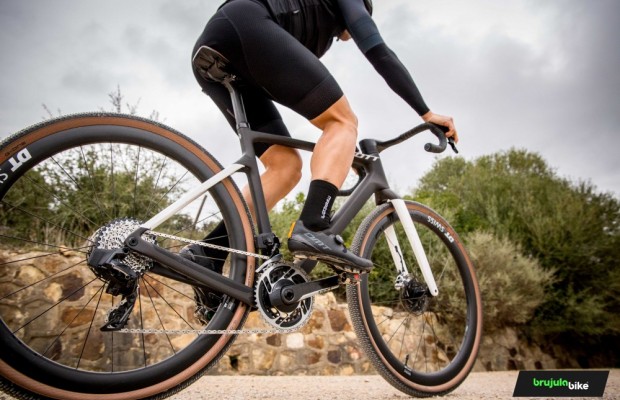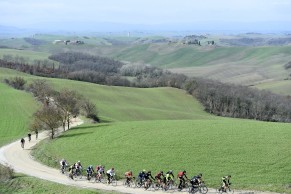Can I do gravel with my road bike?
The rise of gravel has led many cyclists to consider new routes that combine asphalt with trail sections, but can I gravel ride with my road bike?

Beyond the asphalt on your road bike
It is not uncommon to see professional cyclists on social networks doing gravel with road bikes to give variety to their long days of training and, despite being designed to pedal on asphalt, the use of increasingly wider tyres and the robustness of the current machines means that doing gravel with a road bike is not something unreasonable.
Ver esta publicación en Instagram
RECOMENDADO

What is heart rate variability and how does it affect the cyclist?

Change wheels if you want to transform your bike's behavior

What bike size do you need? Here's how to find out

How does age affect performance and recovery?

10 tips for safer and faster downhills on road bikes

The best gravel groupsets of the moment
Obviously, we are talking about the more moderate version of gravel, choosing dirt tracks in reasonably good condition, but in the end, how far we can go will ultimately depend on who is on the bike and the tyres they use.
Actually, this gravel riding with a road bike is not something new. You only need to look at old photos from the Tour de France, the Vuelta or other races to find images of cyclists with the spare tubular strapped to their chests and riding on roads where asphalt was absent.

In fact, this type of cycling was the germ of l'Eroica, the pioneer among the classic bike races that every October runs through Tuscany recovering that cycling with a vintage flavor. A race that was also the germ of what many have come to call the sixth monument, the Strade Bianche.
A race in which it is clear that gravel on a road bike is perfectly possible, not only for the professionals who ride the white roads of Tuscany, but also for the thousands of cyclists who the next day take part in the Gran Fondo that follows the same route.
As an example, gravel as such was born in the United States, where no sooner are you riding along a perfectly paved road than it suddenly becomes a dirt road for many miles, especially in the wide open spaces of the central and western parts of that country. Looking for a specific type of bike for this situation that was so often encountered on the road bike trails was what led to the first gravel bikes.
Doing gravel with the road bike can also be a good resource when it comes to linking road routes by a stretch of track that can help us avoid taking a long detour or, as happens in some cases, crossing a road that is in even worse condition than a track can be. Fortunately, in the latest Strava update, the well-known application has included the gravel route layout among the available options, making it much easier to explore these links on dirt tracks.
To be considered
If we plan to do gravel with the road bike we must take into account some aspects so that the experience does not go from a fun section to a horror movie.
First of all, the condition of the tracks where we are going to ride. If the enemy of gravel bikes are the stones, this is multiplied even more when our tyres are thin and without studs. The presence of stones can easily cause a cut in the tyre that puts an end to our route.

To minimize risks, we will use tyres with the largest balloon that our bike can accept. Nowadays there are road bikes that accept tyres up to 700x38c, although, with a 25 tyre it is feasible to ride occasionally on trails as long as they do not have too many loose stones.
In any case, if we want to do gravel with the road bike we can always do it with greater guarantee if we use tubeless tyres that allow us to lower the pressure to achieve a sufficient level of absorption while avoiding punctures.
Anticipate
Another aspect to take care of when riding a road bike on dirt tracks is the handling. We must not forget that road tyres do not have lugs that allow grip when we face a curve.
The technique for gravel riding with a road bike is very similar to the one we apply when riding on wet asphalt, taking the curves with the smoothest possible line, avoiding braking with the bike leaning and leaning the bike as little as possible.
When riding on track sections it is very important to look a few hundred meters ahead and anticipate our positioning in order to avoid stones, potholes and to choose the cleanest and fastest line. Often the ruts of the cars are the part with the least stones as these are expelled by their tyres. However, it also happens, especially on steep sections, that the surface of the road curls, making it practically impossible to pass with the bike.

In fact, we must be attentive to these curls because, at high speed, it is very easy to end up with our bones on the ground.
In many cases, the best part of the road to ride on is just where the divide between the dirt and the ditch is. Those few centimeters of width often have a very stable surface that allows fast and safe progress, especially when it has rained and the ruts are filled with puddles and the center is left with a very soft mud.
What many touring cyclists are afraid of when they go gravel biking with their road bike is that the bike could get damaged. In principle, if we limit ourselves to riding on dirt tracks, there is no problem and nothing will happen to the bike that would not happen to it when crossing a rough road like the many we find in our country. Obviously, we will be attentive to avoid the potholes and stones of greater entity that could give us a displeasure, but more for a possible crash than because the bike is going to break to expose it to this effort.